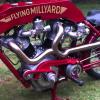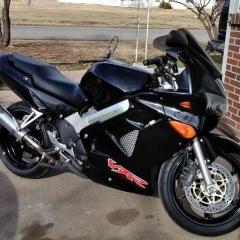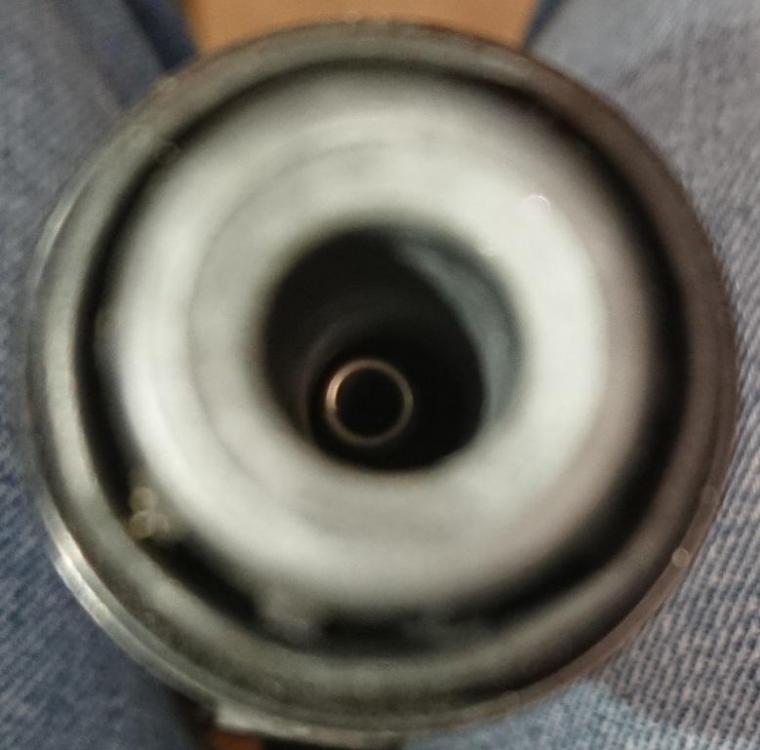
SweViffer
Members-
Posts
30 -
Joined
-
Last visited
Profile Information
-
Location
Sweden
Recent Profile Visitors
1,637 profile views
SweViffer's Achievements
-
No broken spring. Might have been old and not capable to evacuate valve from piston before TDC occured though. Nah, might not be relevant to the OP's question, but perhaps to the "is maintenance necessary" bit of the discussion. I've learned that I need to do more of it than I did, but I'm not certain my experience will influence anyone else. Thought I should tell it anywho... It's a fun story (now). 🙂 And who buys a VTEC and not use the whole rev range? Heresy!
-
Oh, I have more data you might be interested in. Not VFR but VF1kF, but it could be relevant. Too tight valve adjustment and engine revs upto redline resulting in valve and piston connection which in turn suddenly resulted in a very big hole in the engine and engine oil all over the rear tire (at speed). Nice feeling it was not, and the stain in my underwear was majestic... I don't really care to repeat the experience. No warning, no ticks or nothing from the engine, beforehand. I'm not totally sure it was the valve adjustment I might add, but postmortem surely pointed in that direction (top end was surpringsly undamaged!). Edit: When I (re)think about it now, it should really be the valve spring. But I might have catched it if I did regular valve maintence at the time (which I did not). Edit2: Can't produce pictures anymore. Changed the engine for a used one (with it's own problems) and kept the old one for spares. I've now been informed that it's been thrown away by a relative that needed the space for other things, with very mint whole cams and one cam chain tensioner that at least looked serviceable. Am I crying over that fact? Yes! Yes, I am.
-
You're right of course, but generally you can at least try to find a used bike with a service history. It's harder (I would presume) to find just an engine with that documentation. You're also, in most cases, allowed a test drive of a complete motorcycle before purchase, when buying an engine your information stops at a compression test (if you're really lucky, that is).
-
Yes, you can remove the solenoid. But why would you leave the hoses in place, better to get rid of them as well to actually gain some space around the airbox. Buy some silicone hats and put them on the pair valve inlets, or buy some plates and remove the actual valves as well. If you just disconnect the electrical connection to the solenoid, please check that the functionality of the solenoid valve is working (ie that the solenoid valve is closed and blocking air flow). It didn't on my bike, so after that the reed valves coxed enough I had an always open connection from the exhaust to the intake (airbox). That didn't work wonders for performance and mileage! It ran really REALLY rich. My advice would be, either leave the PAIR system alone, and do the regular maintenance of the PAIR reed valves (ie clean them regularly), or block of the PAIR system completly. Don't just disconnect the electrical connector, at least not long term. If you run a Power Commander or a RapidBike with auto-tune, you need to block of PAIR. If you do not you don't gain anything other than a little less popping in the exhaust.
-
Yeah, but with that replacement engine you have no idea whatsoever what the PO thought was unnecessary maintenance due to the infallibility of Honda engines (or plain laziness). It could even include lack of oil changes (why change oil in a Honda engine, they run well for thousands of miles without it) or air cleaner (or even worse, they bought an "performance" air cleaner and didn't maintain THAT with regular cleanings and oilings). I much rather ride on a bike with an engine I know is healthy and well maintained. But enough nagging from me. Have a nice ride! 🙂
-
Just to add data: did the valve check at recommended 48000km. Three tight valves. VTEC 2002. None of the tight valves were VTEC-valves if I remember correctly. Honda makes good engines, but they don't make magical unicorn engines that don't need maintenance regularly (we'll have to wait for them to jump on the electric bandwagon for that to happen). Each to their own, but I felt I liked my bike enough to service it as Honda intended. And I had the monetary means to do it as well... Edit: And to add even more data: the valve clearance adjustments fixed my sometimes hard to start symptoms completely.
-
intermittent vibration at about 3500 to 10000 rpm
SweViffer replied to Wot4y's topic in Earlier VFRs
Another thing, are the fuel lines ok? They could be on the limit fuel flow wise, and when the rubber gets warm and expand slightly they could possible restrict fuel flow enough so that you get starvation. But since you've changed other rubber parts maybe you've changed the fuel lines as well recently? -
intermittent vibration at about 3500 to 10000 rpm
SweViffer replied to Wot4y's topic in Earlier VFRs
Open the fuel cap when experiencing vibrations. Is the vibrations suddenly gone? Then you have a breather problem. If not, the breather is at least not the main problem. -
intermittent vibration at about 3500 to 10000 rpm
SweViffer replied to Wot4y's topic in Earlier VFRs
Have you checked the coils and pickup when warm? You don't have any vibrations when cold, so the error needs to manifest itself before diagnosing is possible. Would be my guess anyway, but I'm not nearly as experienced as for example squirrelman. -
I've checked now. There are no petals to adjust, there is just a spring pressing on the plug top from above. I think it's by design, as all four COP are the same. I also checked a modern Volvo COP and its the same, no adjustable petals in the plug connector. The spring will push out the plug when inserted in the COP if there is no tight water seal, just as being done when inserting a too small plug into the COP. The plugs are being kept in permanent connection with the spring by securing the COP to the valve cover... My springs don't look worn or rusty, so I guess they're fine. Mind you, I've recently experienced misfires on a GM engine when the spring, even though looking in mint condition, in their COP vibrated sideways inside the COP during running so still not 100% sure. I guess the 6th gen differs from the 5th gen petal wise. 🙂 I've attached a photograph of a COP where you can see the spring. Sorry for the slightly blurry picture, it was hell to get the flashlight to light up into the plug cover... The springs diameter is slighty smaller than the spark plug top so that it is kept in contact by pressing the COP down onto the plug by securing the COP onto the valve cover.
-
I'll fix that, thanks for the tip. At the moment my bike is disassembled waiting for a new clutch center and some filing on the clutch basket. But as soon as that is taken care of I'll get back to tracking the vibrations.
-
It was not the spark plugs. Well, it could still be a misfire at higher rpm's I guess, but it runs beautifully at idle. I've since started to suspect the clutch. I've got problems shifting gears as the clutch don't disengage so I dismantled everything. The clutch center has grooves in them that could very probably explain the sticky clutch, but its another thing that puzzles me. When I manually quickly turn the clutch center alternativly between directions (the proper word eludes me), see attached Youtube movie, there is a noticeable rattle. Is this normal? Is there anything in the clutch that could produce vibrations? What should I check? There is no give at all in the clutch basket when mounted as in the movie, it's steady as a rock in every direction. Some grooves in the basket as well, but not as deep as in the center. Could it be the needle bearing? Should I notice some movement from the basket at all if the needle bearing or the clutch outer guide were worn? Or is the main drive gears preventing such movement to be noticable without dismantling stuff further? I'm at a loss.
-
My bike's done 51.000 kms, and had the valves done at around 50000 kms (three tight valves, so obviously Honda don't manufacture magical engines that don't need valve checks). Vibrations started at around 47000 kms, and the valve adjustment was done as fault finding. Don't really know how to test actuation of separate VTEC valves, but the general VTEC kick is present at the right temp and rpm... Vibrations start before VTEC actuation, and are present during and after as well. Any tips accepted gladly! 🙂 The Denso plugs was supposed to have the correct VFR gap settings (specified on the box), but I'm almost certain now that they didn't. The reason I did not check them before was due to laziness, I don't own a wire type feeler gauge just classic rectangular type not suited to iridium plugs. The spark plugs fit, the 5th gen uses the same threads, and the tops are correct. My reasoning was that if the rubber boot doesn't seal there is the possibility of the current taking a different path to ground at speed, heat and compression. I'll soon have factual data on that, since my new plugs arrived in the mail today. What I might have failed to communicate in my first post was that the rubber boot seals to my old NGK plugs really tight, and holds the plugs in when letting them go when inserted into a lose ignition coil. If I try the same with the 5th gen Denso plug it falls out, ie no seal at all. The spring that makes the electrical connection to the plug does not hold anything, its just a spring with lower diameter fit to make an electrical connection to the top of the plug. Obviously you dont rely on the boot to hold the coil to the plug when normally running the engine, thats why you bolt the coil onto the valve cover I guess. 🙂 The boots themselves look pristine, but I guess thats no guarantee that they haven't cracked. Will check that there is spark with HEI tool, both cold and hot as soon as possible. New chain, new sprockets. Yes, I bought the OEM front sprocket with the rubber damping. And yes, there are vibrations when standing the bike on the center stand. The electrical connections and me have a rather rough relationship at the moment. I'm going over them for the fourth time with a file removing every sign of corrosion (have got the charging up to 14.2V at idle with headlights on at the moment without Vfrness or any modifications to a european 2002 wire harness, with original R/R and stator). But as I said, the signals to the coils are correct, both the 12V feed, ground and the signaling (checked with oscilloscope). Have not checked the coils as of yet, awaiting tool for HEI testing. There is traces of fine white dust coating on the rubber boots down by the plug connection... First installation I did as you specify, after that I've torqued them to 12 Nm (as according to the shop manual). Interesting, I didn't know that they are deemed useless after three goes. Well, another reason to change them then... Thank you for your response!
-
Background: I have had a vibration issue with my bike for awhile, which occured suddenly after a full hot summers day of running my beloved VFR around a gocart track for a whole day at top speed. After that I rode it home on the highway and noticed engine vibrations that started at around 5.5k rpm and continued all the way up to the redline. I may have described the issue elsewhere here, or possible there (points at some other forum). I've gone through the usual suspects, like compression, drive chain, engine mounts, starter valves and injectors, but nothing have cured the problem. Current affairs: I had a list of further things to check this winter to get rid of the problem, but had to order tools to get to it. Well, after doing my second hot compression test (I need to be sure after all) I thought I could prepare myself for the next step (HEI testing, with my new tool that will arrive shortly) when everything already was taken out of the engine, so I placed one of my current spark plugs into the ignition coil and lo and behold it fell right out again. Hmm, that can't be right, can it? Tried with one old spark plug I had lying around since my change (I changed spark plugs well before the background gocart run) and that trusty old NGK plug stuck inside the coil as a very warm sweaty hand in a goretex glove. I have checked what I could regarding the ignition, like signal levels to all ignition coils. I also have had no problem at all with jerky idle, it runs smooth as a babys butt at 1250 rpm (I do have very well performing starter valves after several syncs...). Proceeding to check out the plug I took out of the bike. The plug is marked Denso IUH27. It was sold to me by Partzilla, as a replacement spark plug for a 2002 VTEC VFR. I double checked the part number at the time with Denso, and they said it would fit my bike. I checked it again tonight, and now Denso says that it fits a VFR from 2000-2001, ie a 5th gen bike. The spark plugs are almost identical, but the 5th gen version is slightly thinner at the ceramic part. Another thing I noticed when closely examining the two different spark plug is that the Denso plugs have a noticeable bigger gap, even though they are supposed to be identical. Probably slightly worse quality control by Denso, I don't know. Or maybe my high rpm misfires (if the vibrations are misfires) have done bad things to the plugs, but they don't appear to be worn? There are no carbon traces on the Denso plugs and no miscoloration of the tips either, they look pristine. I haven't concluded that they are the culprit, but new spark plugs are in the mail. Thanks to Brexit the pound is lower so I ordered these new NGK's from the UK instead of the US. I'll report back if there's interest. What is the consensus here, are the plugs likely culprits? I hope so, I'm slightly tired of chasing these illusive vibrations.
-
Closed VTEC intake valve...fuel puddle?
SweViffer replied to TurdFerguson's topic in Sixth Generation VFR's
A closed valve means there is no gas flow down that pipe, in other words there is no (or very little) fuel getting there at normal running. If you see a lot of fuel accumulated on your VTEC-valve you most certainly have other problems not related to the actual VTEC functionality. My guess would be leaky injectors or perhaps a broken fuel pressure regulator. Those errors would also explain your poor milage. The milage of a fully working VTEC VFR is not poor, it might not be excellent but not poor. Question: Do you have a fuel puddle on ALL your VTEC intake valves? If yes, what have you fed your injectors?

.thumb.jpg.e25635faf3d19c5c806399bf7f087432.jpg)





